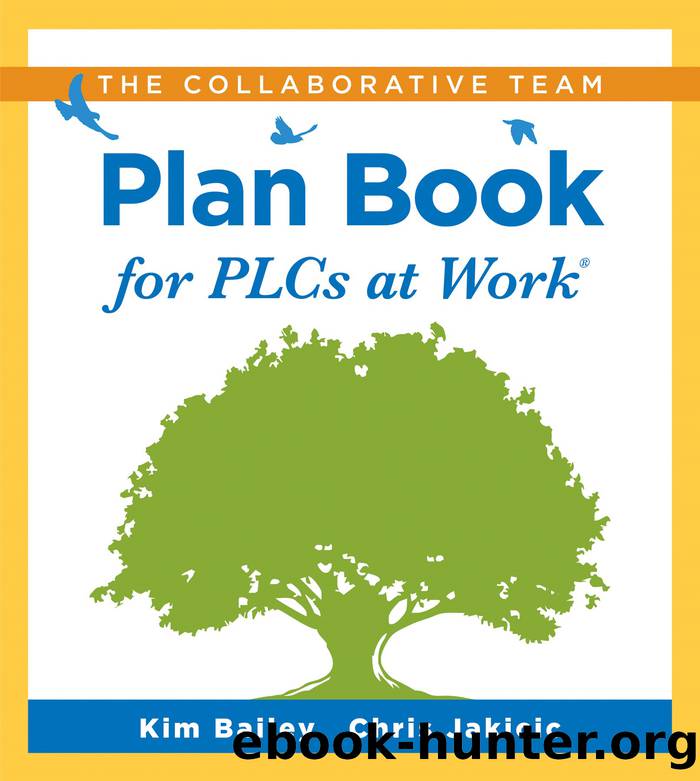Collaborative Team Plan Book for PLCs at Work® by Bailey Kim;Jakicic Chris;

Author:Bailey, Kim;Jakicic, Chris;
Language: eng
Format: epub
Publisher: Solution Tree
Published: 2020-09-15T00:00:00+00:00
How Do We Support New Team Members?
When team members work together over time, they become familiar with each otherâs beliefs, collaboration style, strengths, and weaknesses. They choose norms to guide their work, knowing they might have difficulty maneuvering through complex ideas, new strategies, and even personality differences. As they engage in new learning, they develop trust with each other and become more confident about their work.
When a team gains new members, typically at the beginning of a school year, the dynamics of the team change. We know some new members like to wait to speak up until theyâve learned the lay of the land, so to speak. Others want to be heard from the beginning. Rather than leaving this up to the new member, itâs helpful for existing team members to share from the beginning norms related to soliciting input and making decisions. Help new members understand routines in place to use time effectively, such as team roles and protocols. Additionally, use the following suggestions to help new team members become a strong and valuable addition to your team.
⺠Take time to write new norms: This allows new members to hear why the team adopted specific norms in the past and allows everyone to consider, once again, what agreements should remain in place for the team to function effectively.
⺠Ensure participation in SMART goals: If itâs the beginning of the school year, the team will be writing new SMART goals. Make sure your new team members understand and engage in the process so that they know how they can support the action plan the team develops. If membership changes within the team occur during the school year, make sure to go over with new members the specifics about the SMART goals the team is working toward.
⺠Review team products: You do not need to start over with the products your team has already created, but it is important that the team ensures any new members thoroughly understand each product. For example, explain how the team selects its essential standards and how unit plans allocate time for common formative assessments and responses.
⺠Make shared learning a priority during transition: If the team has built understanding of an idea or strategy in the past, provide ways for new members to catch up with what the team is doing. This may necessitate sharing articles or books, coaching them on using a digital tool or website, sending them to specific training opportunities, or even allowing them to observe another member during instruction. Recognize that this will take time.
⺠Listen to and discuss new membersâ ideas: All teams benefit from new insights in this work. Even if the team opts not to implement a new idea, the discussion surrounding it will be valuable to everyone and help new members feel valued.
Think about how helpful it will be to all team members to revisit and reflect on previous, long-standing team decisions along with the reasons team members made those choices. In the urgency to move forward, teams sometimes forget to make time for this reflection.
Download
This site does not store any files on its server. We only index and link to content provided by other sites. Please contact the content providers to delete copyright contents if any and email us, we'll remove relevant links or contents immediately.
The Art of Coaching Workbook by Elena Aguilar(48570)
Trainspotting by Irvine Welsh(20139)
Twilight of the Idols With the Antichrist and Ecce Homo by Friedrich Nietzsche(17753)
Fangirl by Rainbow Rowell(7893)
Periodization Training for Sports by Tudor Bompa(7376)
Change Your Questions, Change Your Life by Marilee Adams(6702)
This Is How You Lose Her by Junot Diaz(5844)
Grit by Angela Duckworth(4777)
Red Sparrow by Jason Matthews(4733)
Asking the Right Questions: A Guide to Critical Thinking by M. Neil Browne & Stuart M. Keeley(4641)
Paper Towns by Green John(4208)
Room 212 by Kate Stewart(4150)
Ken Follett - World without end by Ken Follett(4002)
The Sports Rules Book by Human Kinetics(3630)
Housekeeping by Marilynne Robinson(3454)
The Motorcycle Diaries by Ernesto Che Guevara(3376)
Exercise Technique Manual for Resistance Training by National Strength & Conditioning Association(3329)
Introduction to Kinesiology by Shirl J. Hoffman(3327)
Papillon (English) by Henri Charrière(3321)
